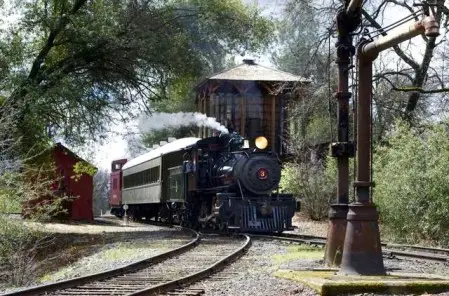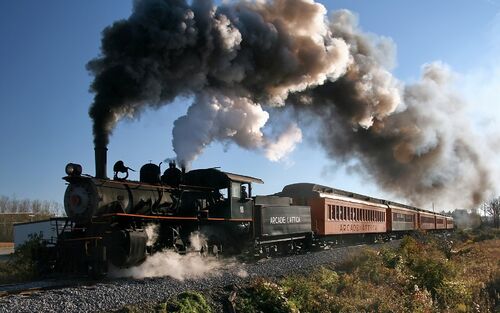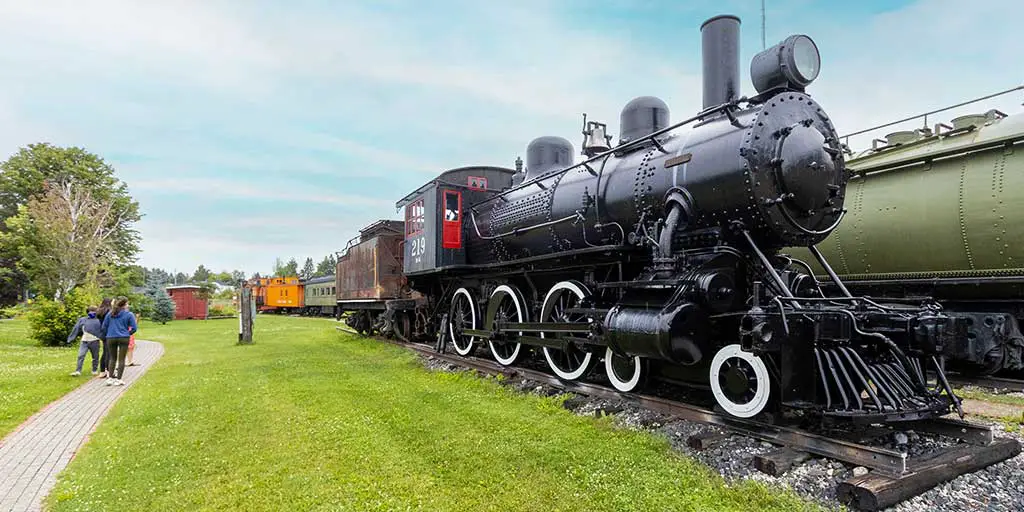Nestled in the rich history of American transportation lies the narrative of Prescott’s railroad history and its economic implications. A journey through time reveals the intricate relationship between the development of railroads in Prescott and the ensuing economic growth that transformed the region.

In this article, we will explore these connections, uncovering the milestones, challenges, and cultural shifts that shaped both the railroads and the economy of Prescott.
Brief Overview of Prescott’s Geographic Significance
Prescott’s location offered an ideal hub for transportation and commerce. Its strategic position served as a vital connection between key cities and states, enabling easier trade and fostering economic growth. The geographical features allowed the railroads to thrive, making Prescott an essential part of the nation’s transportation network.
With its historical significance and unique location, Prescott’s development into a transportation hub was inevitable. The city’s positioning provided not only an excellent ground for the railway system but also a means to bridge various economic gaps.
Initial Exploration of the Railroad Industry
Railroads began shaping Prescott’s landscape in the 19th century. These initial lines served the critical purpose of moving goods and passengers, fostering connections that were previously unimaginable.
Investment in railroads, paired with Prescott’s growing importance, had an immediate impact on the economy. Job creation, increased trade, and access to new markets allowed Prescott to blossom into a thriving economic center.
Connecting Railroads with Economic Growth
The marriage of Prescott’s railroads and economic expansion is a testament to the transformative power of transportation. By linking communities, railroads facilitated trade, brought investment, and opened up new economic opportunities.
The story of Prescott’s railroads is not merely about steel tracks and locomotives; it’s about the empowerment of a region, the forging of connections, and the generation of prosperity that continues to echo through time.
Prescott’s Early Railroad Beginnings
Prescott’s Early Railroad Beginnings lay the groundwork for a transportation system that would eventually shape the entire region. During this initial phase, visionaries, engineers, and entrepreneurs came together to build the first railway lines, forging connections that had never existed before.

These early railroads were more than mere tracks; they were a promise of progress, a glimpse into a future filled with possibilities. The challenges were numerous, from engineering hurdles to financial constraints, but the determination to create a network that would facilitate travel and trade prevailed.
Prescott’s early railroad history is a testament to human ingenuity, collaboration, and the relentless pursuit of innovation, setting the stage for an industry that would become a defining feature of the region.
First Railroad Lines: Purpose and Construction
The early railroad lines in Prescott were initiated with a clear purpose: to connect local industries and neighboring states. The construction of these lines was a remarkable feat that symbolized progress and innovation.
Prescott’s first railroads not only symbolized technological advancement but also laid the foundation for the city’s economic growth. Connecting agricultural, industrial, and commercial sectors, these railroads were instrumental in shaping Prescott’s future.
Early Investors and Benefactors
Investors and benefactors played a pivotal role in the development of Prescott’s railroads. Prominent business figures invested in this burgeoning industry, recognizing the potential for exponential growth.
Their investments not only fueled the expansion of railroads but also contributed to a broader economic surge in Prescott. The early benefactors were visionaries who saw beyond the immediate gains, contributing to a legacy that continues to thrive.
Economic Impact on Local Communities
Prescott’s early railroads were more than just tracks and trains. They were lifelines for local communities, providing access to goods, services, and opportunities. The economic impact was palpable, transforming small towns into bustling centers of commerce.
A closer examination of Prescott’s local economy during this era reveals the true magnitude of the railroads’ effect. Employment opportunities, increased property values, and local business growth were just some of the benefits that the railroads brought to the communities they touched.
Expansion Era: Linking the Country
The Expansion Era marked a pivotal time in Prescott’s railroad history, as it saw the linking of the country through an intricate network of railway lines. This period was not just about extending tracks; it was about bridging gaps, connecting communities, and fostering a sense of national unity.
Railroads became the veins of the nation, allowing goods, ideas, and people to flow freely and efficiently across vast distances. In Prescott, this expansion played a critical role in transforming the local economy, boosting trade, and enhancing communication.
The Expansion Era continues to be a symbol of Prescott’s commitment to innovation, connectivity, and the shared vision of a united nation.

Extending Lines and Connecting Major Cities
The extension of railroads to major cities was a significant step in Prescott’s railroad history. Connecting to cities like Chicago and San Francisco elevated Prescott’s status, turning it into a major transportation hub.
Prescott’s extended lines weren’t just about transportation; they were also about economic expansion. They opened new markets, facilitated trade, and created a network that made the U.S. economy more dynamic and interconnected.
Influence on Trade and Commerce
Trade and commerce experienced a renaissance during Prescott’s railroad expansion era. Goods could now move faster and more efficiently, and new markets were accessible to businesses of all sizes.
The impact on trade and commerce can still be felt today. The railroads reshaped how business was done, paving the way for a more globalized and competitive economy.
Integration with Other Transportation Modes
Prescott’s railroads were not isolated entities. They integrated with other transportation modes, such as shipping and road transport. This integration created a seamless system that further optimized the movement of goods and people.
The synergy between different modes of transport strengthened Prescott’s position in the national transportation network. This integration was not just a logistical success but an economic triumph, fueling further growth and development.
Railroad Innovations in Prescott
Railroad Innovations in Prescott symbolize a period of technological advancement and strategic development that significantly shaped the region’s transportation landscape. From implementing cutting-edge engineering techniques to introducing more efficient scheduling and logistics, these innovations led to a more effective and accessible railroad system.
The improvements not only expedited travel but also expanded economic opportunities by making goods and services more readily available to a broader audience. The impact of these innovations on railroad efficiency continues to resonate in Prescott’s modern transportation infrastructure, reflecting a legacy of ingenuity and progress.
Technological Advancements
From steam locomotives to electric trains, Prescott’s railroads embraced technological advancements. Innovations such as automatic signals and air brakes made the railroads more efficient and safer.
These advancements not only enhanced the railroads themselves but also contributed to Prescott’s economic vitality. By adopting new technologies, Prescott’s railroads became a symbol of progress and modernity.
Safety Measures and Standards
Safety was a core concern in Prescott’s railroads. Standards and regulations were implemented to ensure the well-being of passengers and workers alike.
Prescott’s commitment to safety was evident in its implementation of stringent safety measures. These measures not only protect lives but also increase the efficiency and reliability of the railroad system.
Impact on Railroad Efficiency and Accessibility (Continued)
to the general public. This efficiency not only improved travel but also broadened economic possibilities, making goods and services accessible to a wider audience.
The efficiency and accessibility introduced during this innovative period played a vital role in maintaining Prescott’s position as an economic powerhouse.
The Golden Age of Prescott’s Railroads
The Golden Age of Prescott’s Railroads marked a time of unparalleled prosperity and dominance in transportation. During this era, railroads became the primary mode of travel and commerce, contributing to robust economic growth and fostering a unique cultural shift within society.
It wasn’t just a period of financial success; it was a time when railroads became deeply ingrained in the fabric of daily life, influencing arts, culture, and community. The echoes of this Golden Age can still be felt in Prescott today, reflecting a rich heritage and a time when railroads were the heartbeat of the region.
Economic Prosperity and Railroad Dominance
Prescott’s railroads reached a peak during the Golden Age, when they became the dominant mode of transportation. This era was marked by robust economic growth, fueled by the railroads’ reach and efficiency.
The prosperity during this time was unparalleled, as railroads facilitated unprecedented economic activities, cementing Prescott’s reputation as a key player in the nation’s economy.
Cultural Impact and Influence on Society
The Golden Age of railroads in Prescott also brought a cultural shift. Railroads were not just about commerce; they became a part of the social fabric, influencing arts, culture, and daily life.
The cultural impact of railroads can still be felt today, reflected in Prescott’s rich heritage and vibrant communities.
Challenges and Competition with Emerging Technologies
Despite the success, challenges were on the horizon. Emerging technologies and competition from road and air transportation began to challenge the dominance of railroads.
This competition forced Prescott’s railroads to adapt, innovate, and find new ways to maintain relevance in a rapidly changing world.

Decline and Revitalization of Prescott’s Railroads
The decline and revitalization of Prescott’s Railroads is a story of resilience and adaptability. Faced with challenges such as economic downturns, competition from alternative transportation modes, and shifting industrial focus, the railroads experienced a period of decline.
However, concerted efforts to revitalize and modernize the system breathed new life into this vital transportation network. Investments in infrastructure, the adoption of modern technology, and strategic alliances have reimagined Prescott’s railroads for the modern era, showcasing their enduring importance to the region’s economic vitality and cultural legacy.
Factors Contributing to Decline
Several factors contributed to the decline of Prescott’s railroads. Economic downturns, competition from alternative transportation modes, and a shift in industrial focus all played a role in this decline.
Understanding the decline requires an examination of broader economic and social factors that influenced Prescott’s railroads during this period.
Efforts to Revitalize and Modernize
Despite the challenges, efforts were initiated to revitalize and modernize Prescott’s railroads. Investments in infrastructure, adoption of modern technology, and strategic alliances helped breathe new life into the railroads.
The revitalization of Prescott’s railroads was more than a comeback; it was a reimagining that aligned with modern needs and expectations.
Current State and Future Prospects
Today, Prescott’s railroads are a blend of history, innovation, and potential. While they may not dominate as they once did, they continue to play a vital role in transportation and the economy.
The future prospects for Prescott’s railroads are promising, with ongoing investments and plans for expansion that acknowledge the unique history and potential of this transportation system.
FAQs: Prescott’s railroad history and its economic implications
What role did Prescott’s railroads play in the nation’s economy?
Prescott’s railroads were instrumental in connecting cities, facilitating trade, and fostering economic growth. They played a vital role in shaping the economic landscape of the region and the nation.
How have technological advancements influenced Prescott’s railroads?
Technological innovations in Prescott’s railroads have led to improvements in efficiency, safety, and accessibility. These advancements continue to shape the railroads’ operation and impact.
What challenges did Prescott’s railroads face, and how have they been addressed?
Challenges such as competition from other transportation modes, economic downturns, and technological shifts have been faced by Prescott’s railroads. Efforts to modernize, invest in infrastructure, and adapt to changing needs have helped address these challenges.
Conclusion
Prescott’s railroad history and its economic implications are a compelling tale of growth, innovation, challenges, and resilience. The railroads of Prescott are more than just tracks and trains; they are a living testament to the transformative power of transportation and its ability to shape economies, cultures, and lives.
In exploring this history, we uncover the essence of Prescott’s railroads and their lasting impact on the world around us. Their legacy continues to resonate, offering lessons and insights that reach beyond the realm of transportation and into the very fabric of our society.



Leave a Comment
You must be logged in to post a comment.